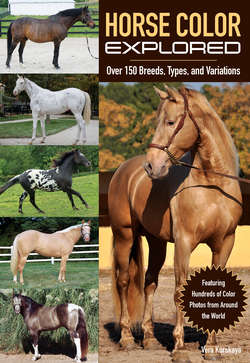Читать книгу Horse Economics - Vera Kurskaya - Страница 17
На сайте Литреса книга снята с продажи.
A LITTLE ABOUT TRAITS
ОглавлениеNow let us discuss genes that can amplify, weaken, or otherwise modify the action of other genes. Such genes are called genetic modifiers. An organism’s phenotype can be formed by the action of two or more of these non-allelic or complementary genes, which in combination create an effect other than what the genes would on their own. Examples in horses are the genes Extension and Agouti, the first of which codes for the production of black pigment, and the second of which distributes the black pigment throughout the horse’s body. Another genetic modifier is a gene that masks the expression of non-allelic genes, called epistatic.
Traits in living organisms are divided into quantitative and qualitative. Quantitative traits can be measured—that is, they are the kind of trait where how much you have can vary: body weight, height, and the thickness of bones, for example. Quantitative traits are usually not the product of one gene, but instead are coded by several pairs of genes and have a so-called polygenetic inheritance.
Qualitative traits, on the other hand, are usually monogenetic or influenced by a single gene. The phenotype is either/or—that is, you have one variant of the gene or another that dictates how it manifests. Pigments and blood type are examples.
When it comes to genes working nicely together (or not), there are other terms to become familiar with and to aim to understand:
Penetrance is the ability of a gene to show itself phenotypically. It can be either complete (manifested in each individual that carries the gene) or incomplete (not phenotypically expressed by all carriers).
Pleiotropic action is when one gene is responsible for two or more phenotypic traits.
Some genes can lead to serious deviations from the norm, such as decreasing its viability (sub-lethal effect) or even leading to death (lethal effect). The loss of an animal due to an unfavorable genotype can occur either at the early stage of embryogenesis or sometime after its birth.
Some genes located on the same chromosome can be linked and transferred together to offspring. Their pattern of inheritance differs from that of unlinked genes.
A mutation is a change in the DNA sequence of a cell or its locus. The extent of mutations can range from a single or few nucleotides to entire chromosomes. Mutations lead to variation and ultimately the formation of alleles. The allele that exists in its original “normal” form in the species is called wild. Other alleles of the same gene are the product of mutations involving the wild allele.
With a basic grasp of the vocabulary I’ve introduced in this first chapter, you’ll be able to now appreciate the genetics of horse color as much as you appreciate the myriad colors themselves. In the next chapter we’ll examine over a hundred colors, how they manifest, and the genetic influences at play. Throughout you will find references to the color photographs you can view in the Color Photo Reference sections.
